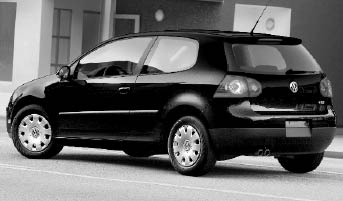Wascally Wabbit Weturns
by Jim Corbran

I imagine there’s a sign hanging in VW’s corporate boardroom which reads: “History repeats itself.” At least, they probably hope so.
This is the only explanation I can come up with for the sudden name change from Golf to Rabbit as the new fifth generation of the car was about to hit North America. The name change was officially—and quite surprisingly—announced in time for the New York International Auto Show this past April. I say “surprisingly” because the car had already been introduced as the new Golf in February at the Chicago show. As before, the car will be known as the Rabbit only here in North America.
Perhaps a bit of history is in order. I’m sure most of you are familiar with VW’s Beetle, a car whose roots go back to Adolf Hitler and his dream of an affordable “People’s Car,“ or Volkswagen. You probably also remember that the design, which dated back to the late 1930s and lumbered on through the late 1970s, was hopelessly behind the times long before production stopped. VW tried to replace the Beetle with larger models such as the Fastback, Squareback and the dreadful 411/412, but sales continued to plummet.
Turn the clock ahead to 1974 and the introduction of the Golf. Finally, VW had hit on a winning design. But the powers that be decided that the name “Golf” would have no meaning in the Western hemisphere. (“Golf” was a shortened version of the German for “Gulf Stream.” Why they thought we wouldn’t get it is beyond me.) So we got the Rabbit, and Latin Americans got the Caribe. The Rabbit saved VW from financial collapse and has since become its best-selling model ever, with more than 25 million built.
Early versions of the Rabbit sold well in the US, but things started to go sour when VW built a plant in Pennsylvania to try to keep costs down. Along with costs, sales went down, and the plant was sold to Chrysler in 1984. The second-generation Rabbit took the Golf name in our hemisphere, but sales never reached expectations.
Turn the clock ahead once more to the present, and let’s take a look at VW’s attempt to breathe new life into the car.
The new Rabbit has been completely revamped without losing the traditional Golf style. This is probably a good thing for present Golf fans, but I’m not sure how it will help attract the desperately needed new buyers VW is looking for. It’s certainly a modern-looking car and full of features. The automotive press loves it, especially in its GTI and R32 versions (which are, confusingly, still Golfs and not Rabbits). The new Rabbit comes in both two- and four-door hatchback versions, with pricing starting at $14,990. Features include ABS, traction control, fully independent suspension, outside mirrors with integrated turn signals, climate-control a/c and an am/fm/CD/MP3 player with 10 speakers. Power comes from a five-cylinder, 2.5-liter inline DOHC engine which puts out 150 horsepower. A five-speed manual transmission is standard, and a six-speed automatic with Tiptronic Sport mode is available. Both versions are EPA rated at 22/30 miles per gallon city/highway. All Rabbits come with a five-year/60,000-mile powertrain limited warranty, a four-year/50,000-mile vehicle limited warranty and four-year unlimited mileage roadside assistance. And one other thing which, years ago anyway, was a big deal: German craftsmanship.
One other fact: The Jetta—which, when you come right down to it, is not much more than a Rabbit with a trunk—does well in North America but tanks in the rest of the world, where the Golf is king. They all think we’re nuts for choosing the Jetta over their beloved Golf. To each, as they say, their own.
More info at: vw.com.
|
Issue Navigation> Issue Index > v5n33: Act Small, Think Big: The Micropark Revolution (8/16/06) > Wascally Wabbit Weturns This Week's Issue • Artvoice Daily • Artvoice TV • Events Calendar • Classifieds |









 Current Issue
Current Issue